On June 5, the Brookings Foreign Policy program held an on-the-record media briefing ahead of President Trump’s summit with North Korean leader Kim Jong-un on June 12. Below are the six scholars’ remarks on that issue, edited for clarity.
Jung Pak, SK-Korea Foundation Chair in Korea Studies, Senior Fellow in the Center for East Asia Policy Studies: I spent most of my 30s watching Kim Jong-un mature and blossom into this young man who’s proved to be very adept at engagement, and probably no one expected him to be this adroit. For the first six-plus years of his rule, he was very focused on provocative actions and developing nuclear weapons capabilities, as well as cyber capabilities, biological weapons, and more.
For Kim to do this 180-degree turn to engagement suggests to me that he’s good at maximum pressure and maximum engagement. I would say that at age 34, he has learned the diplomacy tools of his father and grandfather: namely, a hub-and-spoke model of engagement, in that he’s addressing each of his neighbors bilaterally. So, he’ll talk to China and say the right things to the Chinese; he’ll talk to the South Koreans and he’ll say the right things to them about blood ties, peace, and unification—all the things that really appeal to the South Korean public and its ambitious politicians.
With the United States, he’s not looking at the U.S. government overall as an entity to deal with, but rather is focusing on how to manage Trump. It appears to me that the North Koreans are looking to appeal directly to Trump’s preferences and priorities, for instance in mentioning the “Trump model” (separate from the Bolton model, Pence model, or whatever model that might exist).
Kim’s hub-and-spoke model of engagement suggests to me that he is aware of and knows how to exploit, or is learning how to exploit, the national priorities of those various countries. For South Korea, the focus is on family reunions and peace. For China, it’s about learning from the Chinese model of development, science, and technology—and it has long been China’s desire that North Korea and Kim would learn from their model.
In looking at Kim’s engagement since January, I think his motivations and goals might have evolved: He sent an olive branch to South Korea, and I think he didn’t expect a summit with the U.S. president to come so quickly out of that. In other words, he might actually be seeing a strategic opportunity in his engagement. It’s not just about releasing the pressures of maximum pressure, but also about moving his goals forward. He sees a South Korean president who’s willing to look away from the nuclear and conventional threats. He sees a U.S. president who is really eager to meet with him for a summit and wants to prove his international standing as a peacemaker, and a U.S. president who is also very openly interested in potentially withdrawing U.S. troops in the Korean Peninsula.
So, I think Kim sees these strategic opportunities. It’s early on in Trump’s presidency, and we could have three or seven years left. With President Moon Jae-in, we have four years left. If things go well for Moon’s party in elections next week, and if peace does happen on the Korean Peninsula, you can foresee another progressive South Korean government coming to power four years from now. Kim might see all this as a way to cement his gains.
Jonathan Stromseth, Lee Kuan Yew Chair in Southeast Asia Studies, Senior Fellow in the Center for East Asia Policy Studies and the John L. Thornton China Center: I cover Southeast Asia at Brookings, and will add a few words about the venue, Singapore, since the upcoming meeting is increasingly being dubbed “the Singapore summit.” Singapore is well-known for punching above its weight in both diplomatic and strategic terms in Asia. Its diplomats are top-notch and have experience hosting high-level, international events—like the historic meeting between Chinese President Xi Jinping and then-Taiwan president, Ma Ying-jeou, in 2015.
Singapore has active and comparatively balanced relations with China and the United States, so it’s seen as a politically neutral host. The venue also offers diplomatic backup for the United States and North Korea since both countries maintain embassies there.
It’s fortuitous that Singapore is the current chair of the Association of Southeast Asian Nations, or ASEAN, a position that rotates annually among the ten countries that make up the regional body. This provides a regional dimension to the summit. North Korea is pretty active in Southeast Asia. It’s well known that Kim Jong-un’s half-brother, Kim Jong-nam, was assassinated in Malaysia last year. North Korea has embassies in most Southeast Asian countries, and North Korea and North Koreans themselves are active in construction, mining, IT, and restaurant businesses in the region, as well as in various illicit sectors and financial activities. So, it is perhaps fitting that ASEAN, and Singapore specifically, is lending a helping hand and playing a facilitating role for this summit.
At the same time, there is frustration in Southeast Asia that the Trump administration is so laser-focused on the North Korea issue. ASEAN nations get frustrated when the United States takes a single-issue approach to the region. They’d prefer if Washington gave greater attention to problems that are more intrinsic to Southeast Asia itself. Although the Trump administration is stepping up efforts to check China in the South China Sea, ASEAN would like to see the United States be more engaged economically in the face of China’s rising economic influence, which gives Beijing leverage in other areas like maritime security. It is not surprising, then, that the administration’s occasional flirtation with rejoining the Trans-Pacific Partnership (TPP) attracts a lot of interest and attention.
The site for the summit itself is the Capella Hotel on Sentosa Island, which is home to golf courses and a popular theme park in Singapore. It will occur during prime-time television hours in the United States, which will likely make our president very pleased. Finally, to dabble in theme park metaphors: I guess we’ll see whether Trump and Kim hitch a ride on a dangerous rollercoaster or a circuitous merry-go-round. Perhaps we should all hope for a modest choo-choo train, slow and steady.
Ryan Hass, David M. Rubenstein Fellow in the Center for East Asia Policy Studies and the John L. Thornton China Center: I’ll focus on potential dynamics of the summit, and at the outset, I’d like to commend President Trump for pursuing diplomacy. I hope that he gives diplomacy a serious chance to work. In fact, there have been a few good indications of that recently: For example, he has acknowledged that this is a problem that will not be solved in a single meeting. He has acknowledged that there will need to be a step-by-step or parallel process between the United States and North Korea. And he has acknowledged that in order to reorient North Korea’s priorities toward economic development, the United States and others would need to play a role in supporting a move in that direction.
So although President Trump is an unconventional leader, he is coming around to accepting some of the conventions about diplomacy with North Korea. Where does that lead?
I don’t think it’s too early to envision the broad concept coming out of the summit. There will likely be some expression of shared intention to conclude a peace treaty, as well as some declaration on denuclearization at a future date. The key question will be: How much precision are both leaders prepared to apply to these aspirations?
For example, will the two leaders lay out timelines for denuclearization, including agreement regarding a ladder of follow-on engagements to drive towards that goal? Will they agree on interim steps to build confidence and provide visible proof points of progress? Will Kim Jong-un commit not to proliferate nuclear or missile weapons technology while this process unfolds? Will Kim Jong-un renew his pledge not to test nuclear or missile technologies while talks are ongoing? These are just a few examples, all of which are modest and doable if there is a genuine shared desire to resolve some of the underlying challenges.
So, what will be needed in Singapore is proof that both leaders are on the same page—or at minimum, in the same book in their approach to these issues. I think a declaration of intentions on a peace treaty and denuclearization will get us through the first summit. The key question in my mind is: What follows it?
Michael O’Hanlon, Senior Fellow in the Center for 21st Century Security and Intelligence, Director of Research for the Foreign Policy program: I’ll address two issues: One is to lay out a way to think about a step-by-step process for denuclearization; the second is to think longer term about the U.S.-South Korea alliance if and when the North Korean threat is reduced or diffused (something I wrote about recently in the Wall Street Journal).
In a nutshell, I think a good way to think about denuclearization is a step-by-step process based on the premise that we’re not going to get complete denuclearization completely, right away (as my colleagues Jonathan Pollack and Richard Bush have emphasized over the years). I can’t see a man whose regime has been telling us for many years that it needs nuclear weapons for its security to give these up lightly—even if North Korea got a lot of economic benefits.
It’s more realistic to think about the current freeze on testing being followed by a verifiable cap on the size of the North Korean arsenal. The way you have to do that is to verify that the centrifuges aren’t spinning and that reprocessing facilities aren’t chemically removing plutonium from fuel rods. Which means you need data on where the sites are, you need inspectors, you need to get on the ground.
I think we have to make some inducements to North Korea just to get that, even though it’s a reversible step because they could always kick the inspectors out and turn the centrifuges back on. So, for that stage of capping—the second stage—I think the inducement should be real, but modest. We could suspend a couple of U.N. sanctions, perhaps, or give some humanitarian aid.
The third step is dismantling North Korea’s production capability for making more nuclear weapons and longer-range missiles. At that stage, President Trump could argue that he had gotten further than the Agreed Framework, or even the Joint Comprehensive Plan of Action with Iran, because he could have dismantled and removed from North Korea those capabilities.
This would put a ceiling on the future North Korean nuclear arsenal, and I think for that, we could first suspend and then lift a lot of the U.N. sanctions that have been imposed in the last three years or so. That allows the North Koreans to trade with South Korea, China, Russia, and others. We still would keep the U.S. sanctions on, in my estimation, until he gets to the fourth stage, which is actual disarmament, because we cannot condone a nuclear North Korea and we have to maintain a current principle that this unacceptable. We could continue to have diplomacy with Pyongyang, and we could even have a peace treaty along the way, but I would not lift the entirety of U.S. sanctions until that fourth stage.
So in summary, it’s freeze, cap, dismantle, disarm. Some of these steps could overlap, and you can imagine a down payment of ten nuclear warheads earlier on in the process. I just don’t think we’re going to do very well if we expect all the nuclear warheads to come out in the first year, or even in President Trump’s first term.
On my second topic: People are asking whether could you do a trade of the U.S.-South Korea alliance for North Korea’s nuclear weapons. Another question is: What would be the purpose of the alliance if we ever had a demilitarized North Korea? It’s worth starting to think about—and socialize with South Korea and China—some concepts for why the U.S.-South Korea alliance actually should endure over the longer term. The South Koreans would of course come to their own decisions about what kind of alliance they might want. I think it would be a big mistake to throw away the alliance, even for complete denuclearization.
The threat from North Korea preceded its nuclear program, and conventional, chemical, and other forces could continue afterwards. So the U.S.-South Korea alliance still makes sense in the long term, even if North Korea as a threat goes away.
That debate is worth having, soon, because it’s already being raised. For more on my specific views, I’d direct you to my Wall Street Journal piece (which I summarized on the Brookings website).
Richard Bush, Co-Director of the Center for East Asia Policy Studies, Senior Fellow in the John L. Thornton China Center: I’ll touch on South Korea’s president, Moon Jae-in, who has played a very pivotal role in recent months of diplomacy with North Korea. In February, he seized the opportunity of the Winter Olympics to move towards a bilateral summit with Kim Jong-un, and that was a very impressive media moment. It created not only a good feeling in South Korea, but also gave President Trump a sense of what he himself could have with his own summit.
After President Trump canceled, temporarily, the summit, President Moon hustled to get it back on, meeting with Kim Jong-un again. I think he’s had this ambition for some time, but the fact that he’s achieved it is still impressive. Now, he seems to be overreaching a little bit.
Reportedly, he is seeking a three-way meeting in Singapore: Himself, Kim Jong-un, and President Trump, right after the Trump-Kim bilateral summit. What he reportedly wants is a public declaration of the end of the Korean War, which is still operating under an armistice. This would not be a peace agreement, it would just be a declaration. A peace agreement would come later, and would have to involve China.
I think President Moon is assuming that the Kim-Trump meeting will go well, otherwise this declaration wouldn’t be possible. But if he’s right, and if the declaration occurs, it provides President Trump with the kind of symbolic media moment that he really enjoys.
Why is President Moon pushing in this direction? He’s on the progressive side of the Korean political spectrum. Progressives place less emphasis than conservatives on South Korea’s security problem, more emphasis on creating a process for unification, reducing the relationship with the United States, and creating more autonomy for Korea in a region of great powers. It’s easy for him to imagine I think, it’s really hard to do.
Mireya Solís, Co-Director of and Senior Fellow in the Center for East Asia Policy Studies: [Note: This section has been updated to reflect developments out of the Trump-Abe meeting on June 7. You can also listen to Solís discuss what came of that meeting.] Finally, I’ll discuss Japan. Prime Minister Abe came to Washington last week, his second visit in a few weeks. It was a bit of a gamble for Abe to come to Washington again so soon, since he risked having a strained interaction with President Trump—not only because Japan is consistently skeptical about the chance of a genuine breakthrough with North Korea, but also because the gap between the Japanese position and Trump’s position on North Korea appeared to have expanded recently in some important ways.
Japan remains fully on–board with the idea that there should be a fast deadline for the complete, irreversible, verifiable denuclearization of North Korea, and has been adamant about maintaining the maximum pressure campaign.
In contrast, President Trump now talks about June 12 as part of a longer process where he and Kim Jong-un will get to know each other. And recently, Trump worried the Japanese side by stating that since he is now trying to get along well with Kim Jong-un, he did not want to talk about maximum pressure anymore.
On top of this, the temperature just went up on the trade front, because the Trump administration recently moved to initiate a 232 investigation on the automobile sector, raising the possibility that the United States could impose tariffs. We already have the steel and aluminum tariff action, but it doesn’t compare with the significance of the economic interests that would be involved if the U.S. administration really moves in this new direction.
So why did Abe risk coming at a sensitive time like this? I believe the central objective of his visit was to convey to the the president—just a few days before the summit—the set of core security interests that should not be neglected in talks with Kim: 1) the threat of short– and medium–range missiles—not just those that can hit the U.S. homeland, 2) the threat of weapons of mass destruction (biological and chemical, not just nuclear), and 3) a message that the Japanese government wants the president to deliver to Kim, which is that the abductee issue is not yet resolved, and it must be addressed before normalization of relations can proceed. So with this visit, Abe risked exposing the fact that his personal diplomacy with Trump may be on its last legs, but he came nonetheless because of the overriding concern that Trump’s eagerness to call the June 12 meeting a historical success could result in a bad deal—one that is vague on denuclearization and loosens sanctions.
Finally, on the trade front: Developments of the last week mean that Japan is no longer the only ally punished by the metal tariffs, now the European Union and NAFTA countries are hit. But obviously there’s no comfort in knowing that U.S. trade unilateralism is expanding its reach and punch.
The Brookings Institution is committed to quality, independence, and impact.
We are supported by a diverse array of funders. In line with our values and policies, each Brookings publication represents the sole views of its author(s).


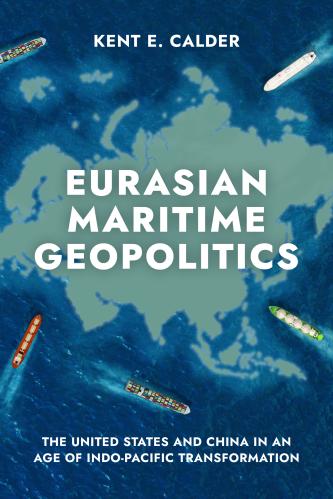
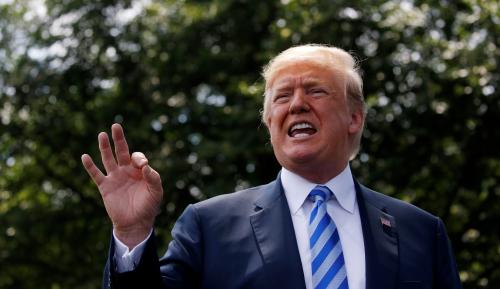
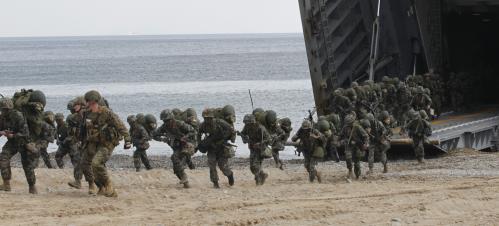
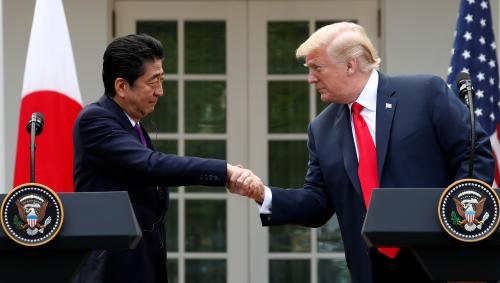



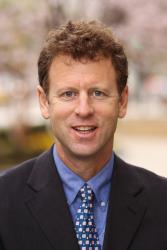


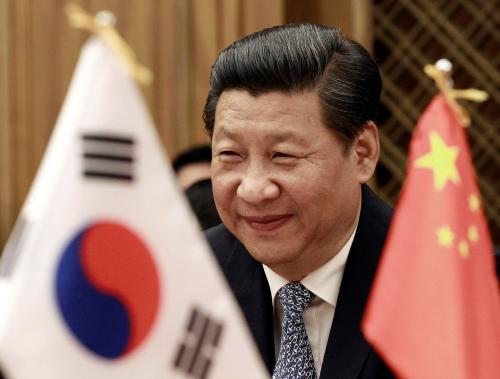
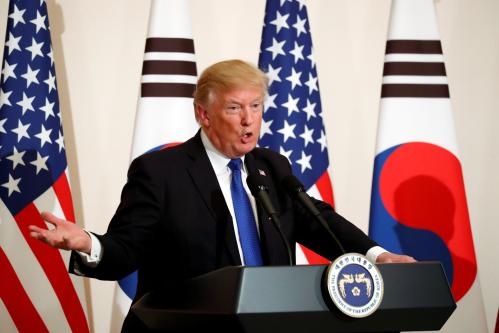
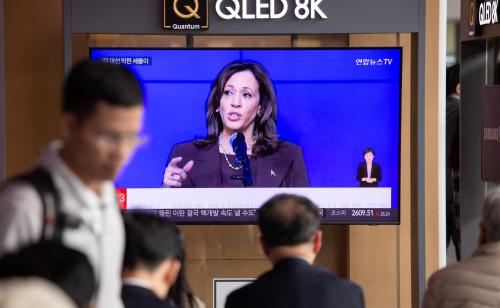
Commentary
What to expect out of the Trump-Kim Jong-un summit
June 10, 2018